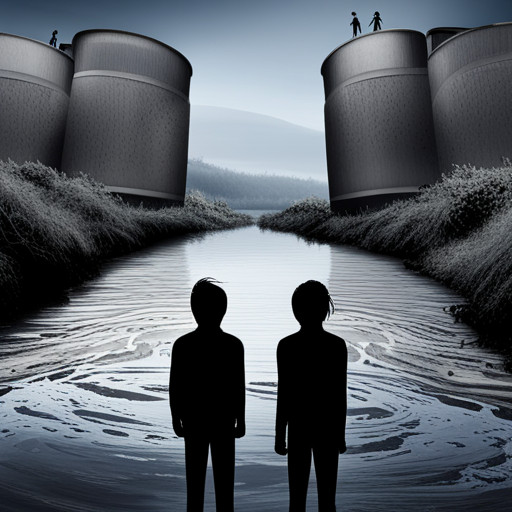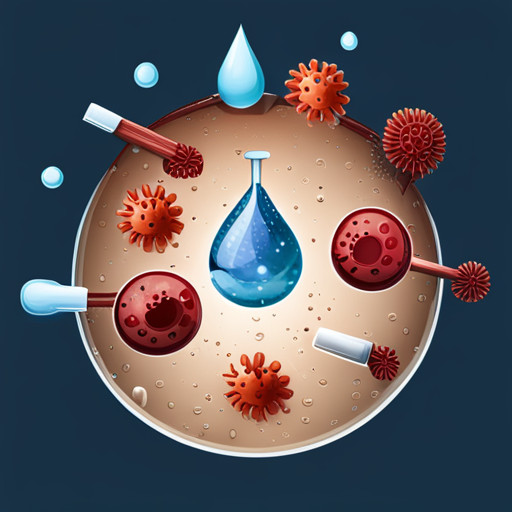Navigating Your Kidney Cancer Diagnosis Post Toxic Water Exposure
Exposure to toxic water has been linked to an increased risk of kidney cancer.

This article delves into this correlation, providing a comprehensive overview of kidney cancer, its diagnosis, and subsequent navigation.
Detailed discussions on symptoms, treatment options, emotional impacts, and support systems will be explored, along with lifestyle adaptations post-diagnosis.
Furthermore, preventative measures to avoid further toxic water exposure will be outlined, offering valuable information for those affected.
Key Takeaways
- Prolonged exposure to contaminated water increases the risk of kidney cancer.
- Carcinogens in contaminated water can cause DNA mutations in renal cells, promoting cancer progression.
- Diagnostic tools like ultrasound, CT scans, and MRI are commonly used to confirm the presence of kidney cancer.
- Treatment options for kidney cancer depend on the stage of the disease, overall health, and patient preferences.
Understanding Kidney Cancer: A Brief Overview

Understanding kidney cancer necessitates a comprehensive overview of its causes, symptoms, diagnosis, and treatment options. A variety of factors contribute to the development of kidney cancer, with genetic factors playing a significant role. Mutation of the VHL gene, which regulates cellular response to oxygen, has been associated with a higher risk of kidney cancer. Environmental factors, such as exposure to toxic substances, including carcinogens in water, can also contribute to the onset of this disease.
The symptoms of kidney cancer include blood in the urine, flank pain, and a palpable lump in the abdomen. However, these symptoms often do not appear until later stages of the disease, making early detection difficult. Diagnostic tools such as ultrasound, computed tomography (CT) scans, and magnetic resonance imaging (MRI) are commonly used to confirm the presence of a renal mass.
Cancer staging is an essential aspect of diagnosing kidney cancer, as it determines the extent of the disease and guides treatment options. The TNM system (Tumor, Node, Metastasis) is typically used, with stages ranging from I (localised disease) to IV (advanced disease with distant metastasis).
Treatment options for kidney cancer depend on the stage of the disease at diagnosis, the patient's overall health, and their personal preferences. Options may include surgery, targeted therapy, immunotherapy, radiation therapy, and clinical trials.
The Connection: Kidney Cancer and Toxic Water Exposure

Research has shown a significant correlation between the incidence of renal malignancy and prolonged exposure to contaminated H2O. A plethora of toxicity sources such as heavy metals, pesticides, and organic solvents present in polluted water contribute to this escalating risk. Specifically, carcinogens in contaminated water can cause DNA mutations in renal cells, which is a critical step in cancer progression.
Toxicity sources such as arsenic, cadmium, and lead are known to be nephrotoxic, causing renal damage that can lead to malignancies. Ingesting water laden with these toxic elements over a prolonged period can lead to chronic renal injury. This damage initiates a series of cellular alterations, including DNA damage, uncontrolled cell proliferation, and suppression of apoptosis, all hallmarks of cancer progression.
Moreover, the carcinogenic pesticides commonly found in contaminated water, such as atrazine and glyphosate, can disrupt hormone balance and induce oxidative stress in renal cells. This cellular stress can lead to DNA damage and mutation, further promoting the progression of renal malignancy.
Organic solvents are another source of toxicity, with proven renal carcinogenic effects. Long-term exposure to solvents like trichloroethylene (TCE) can lead to renal tubular damage, furthering the initiation and progression of renal cell carcinoma.
Symptoms: What to Look Out for in Kidney Cancer

Common symptoms associated with renal malignancy include blood in the urine, lower back pain not linked to injury, and unexplained weight loss. These symptoms are often indicative of a change in kidney function, warranting further investigation for potential kidney cancer.
Cancer staging is a pivotal component in determining the nature and extent of the malignancy. The system utilised for staging kidney cancer is the TNM system, where T denotes the size of the primary tumour, N signifies the involvement of nearby lymph nodes, and M represents metastasis. Early-stage kidney cancer may be localized within the renal capsule, while advanced stages often depict invasion beyond the kidney to surrounding structures or distant organs.
Genetic factors significantly influence the development of renal malignancy. The Von Hippel-Lindau (VHL) gene mutation is closely linked to clear cell renal cell carcinoma, the most common type of kidney cancer. Additionally, defects in the MET, FLCN, and FH genes have been associated with the development of papillary renal cell carcinoma and chromophobe renal cell carcinoma respectively.
The presence of these genetic mutations does not guarantee the development of cancer but increases the likelihood, particularly when combined with exposure to environmental factors such as toxic water. Therefore, genetic testing and counselling form an integral part of the diagnostic process, especially for those with a family history of renal malignancy or exposure to toxic water.
Diagnosis: Navigating the Process of Kidney Cancer Confirmation

Determining the presence of renal malignancy typically involves a multi-step process, encompassing physical examinations, laboratory tests, and imaging procedures.
The diagnostic procedures for kidney cancer generally begin with a medical consultation, where physicians gather a comprehensive medical history and conduct a physical examination to identify any abnormal signs.
Following the consultation, laboratory tests are conducted. These include urinalysis to detect blood in the urine or substances that can form kidney stones, and blood tests to assess kidney function and look for anemia, a common condition in individuals with kidney cancer.
Imaging procedures are integral in the diagnostic process. Ultrasound, computed tomography (CT), and magnetic resonance imaging (MRI) scans provide detailed images of the kidneys, assisting in identifying potential tumors. A CT scan, in particular, can show the size, shape, and location of the tumor, while an MRI provides detailed images of blood vessels and lymph nodes, aiding in determining the stage of the cancer.
In some cases, a biopsy may be recommended. This involves inserting a thin needle into the kidney to extract a small sample of tissue, which is examined under a microscope for cancer cells. The biopsy results, coupled with the patient's medical history and results from the imaging tests, contribute to the final diagnosis.
The diagnostic procedures for renal malignancy require meticulous attention to detail and careful interpretation of results. Given the complexity of these procedures, medical consultations play a critical role in discussing results, potential treatment strategies, and patient expectations.
Treatment Options: Exploring Various Ways to Fight Kidney Cancer

Treatment strategies for renal malignancy range from surgical procedures to targeted therapies, each with its own set of benefits and potential side effects. Surgical procedures remain the cornerstone of treatment for localized and locally advanced kidney cancer. These procedures may include radical nephrectomy, where the entire kidney is removed, or partial nephrectomy, which only removes the tumor and a small margin of healthy tissue. While these techniques are often effective, they carry risks such as infection, bleeding, and potential damage to surrounding structures.
On the other hand, targeted therapies have emerged as a promising option for advanced or metastatic disease. These therapies work by interrupting the pathways that cancer cells use to grow and spread, and they include drugs such as sunitinib, pazopanib, and axitinib. However, these medications can cause significant side effects, including fatigue, hypertension, and hepatotoxicity.
In addition to conventional treatments, alternative therapies are increasingly being explored for their potential benefits. These may include lifestyle modifications, dietary interventions, and the use of natural compounds with anticancer properties. While the effectiveness of these approaches remains under investigation, some preliminary evidence suggests potential benefits in terms of survival and quality of life.
Emotional Impact: Dealing With a Kidney Cancer Diagnosis

A diagnosis of renal malignancy often has profound emotional implications, with patients potentially experiencing a range of responses, including shock, fear, anxiety, and depression. Navigating through the emotional landscape post-diagnosis is an integral part of the journey towards health and recovery. It is important to understand the potential emotional impact and identify coping strategies to harness emotional resilience.
Various factors influence the emotional response to a kidney cancer diagnosis:
* The abrupt disruption of daily routines and plans, causing a sense of loss and uncertainty.
* The physical discomfort and side effects associated with treatment procedures.
* The anxiety and fear of the severity and potential outcomes of the disease.
* The emotional burden posed by the potential financial implications of treatment.
Emotional resilience can be cultivated by adopting coping strategies that help manage these emotional stressors. These strategies may include:
* Seeking emotional support from family, friends, or support groups to share feelings and experiences.
* Engaging in stress-reducing activities such as exercise, meditation, and hobbies.
* Consulting with mental health professionals for therapy or counseling.
* Educating oneself about the disease, prognosis, and treatment options to reduce uncertainty and fear.
It is crucial to recognize that emotional distress is a normal reaction to a cancer diagnosis. Understanding the emotional impact and employing coping strategies can foster emotional resilience, aiding in the overall recovery process. The utilization of these strategies can significantly improve the quality of life and mental well-being of patients dealing with a kidney cancer diagnosis.
Support Systems: Finding Help Post-Diagnosis

The ensuing discourse presents an exploration into the realm of post-diagnosis support for individuals impacted by kidney cancer, particularly in the context of toxic water exposure.
It provides an analytical examination of the process involved in identifying reliable support groups, emphasizing the importance of their role in offering emotional, informational, and practical assistance.
Additionally, it highlights the potential benefits of leveraging online help platforms, which offer accessible, instant, and versatile resources that can significantly aid in the navigation and management of this complex health condition.
Identifying Reliable Support Groups
Identifying reliable support groups often involves thorough research and consultation with healthcare professionals. This process is integral to the Group Selection phase, which can be influenced by Personal Experiences.
* Healthcare professionals often recommend support groups that they have had positive experiences with in the past.
* Online platforms can provide useful reviews and testimonials from previous group members.
* Local community centres often host regular support group meetings and are worth investigating.
* National and international associations related to kidney cancer provide resources for finding reliable support groups.
The selection of a support group is a crucial step in managing a kidney cancer diagnosis post toxic water exposure. A well-chosen group can provide emotional support, practical advice, and a sense of community for individuals navigating this challenging journey.
Leveraging Online Help Platforms
Leveraging online help platforms has become an increasingly popular method for individuals seeking support. These websites often offer a diverse range of resources and forums for discussion. Particularly in the context of kidney cancer diagnosis post toxic water exposure, these platforms offer a plethora of digital therapies. These therapies include virtual consultations, remote patient monitoring, and telemedicine services.
The telemedicine advantages are manifold. They facilitate access to specialist care, especially for those living in remote areas. Additionally, they reduce the need for travel and minimize exposure to potential healthcare-associated infections.
Furthermore, these platforms allow for the sharing of knowledge, experiences, and advice among individuals facing similar health challenges. This fosters a supportive community and promotes patient empowerment in managing their health conditions.
Lifestyle Changes: Adapting to Life Post-Diagnosis

Adapting to life after a kidney cancer diagnosis, particularly post toxic water exposure, necessitates a deep understanding of key lifestyle modifications. These modifications, which include dietary alterations, implementation of exercise regimens, and the utilization of stress management techniques, are instrumental in managing the disease effectively.
Detailed exploration of these elements, grounded in medical research and evidence-based practices, will provide comprehensive insights into the profound impact such changes can have on a patient's health trajectory and quality of life.
Diet Modifications
Modifications in diet can play a crucial role in managing kidney cancer, particularly in patients with a history of toxic water exposure. This approach can include Supplemental Nutrition and Alternative Therapies.
Supplemental Nutrition involves incorporating nutrient-dense foods into the diet, ensuring the body has the necessary vitamins and minerals to function optimally and potentially improve cancer outcomes.
Alternative Therapies, such as herbal or botanical treatments, should be utilized under professional supervision.
The following modifications could further improve health outcomes:
- Reduction of processed foods to decrease sodium intake.
- Increase in antioxidant-rich foods to bolster immune function.
- Regular intake of filtered water to reduce exposure to potentially harmful substances.
- Incorporation of lean proteins to support tissue repair and growth.
These strategies offer a comprehensive approach to dietary modifications for kidney cancer management.
Exercise Implementation
Implementation of regular physical activity has been recognized as a non-pharmacological intervention that could potentially enhance the overall health and quality of life of patients undergoing treatment for various types of malignancies. It has been observed that exercise benefits patients in a multitude of ways including aiding in physical rehabilitation after treatments. The table below outlines some specific advantages of regular therapeutic exercise.
| Exercise Type | Benefits | Rehabilitation Aspect |
|---|---|---|
| Aerobic | Enhances Cardiovascular Health | Aids in Recovery |
| Resistance | Strengthens Muscles | Assists in Mobility |
| Flexibility | Improves Joint Function | Aids in Bodily Comfort |
| Balance | Reduces Fall Risk | Enhances Stability |
| Endurance | Increases Stamina | Aids in Daily Activities |
Stress Management Techniques
Transitioning from the role of exercise in managing kidney cancer post toxic water exposure, the focus now shifts to the significance of stress management techniques. In the midst of a health crisis, stress levels can escalate, potentially exacerbating the situation. Here, the utility of Meditation Practices and Deep Breathing Techniques becomes evident.
* Meditation Practices: Meditative techniques promote relaxation, reduce stress, and heighten mental clarity, thus contributing to overall well-being.
* Deep Breathing Techniques: Deep, controlled breathing exercises can aid in reducing anxiety and promoting a sense of calm, potentially lessening stress-induced physical symptoms.
Furthermore, these techniques can be integrated into daily routine, allowing the individual to regain some control, which can be empowering during the uncertain journey of cancer diagnosis and treatment.
Prevention Measures: Avoiding Further Toxic Water Exposure

Precautionary measures, such as regular water testing and the use of certified water filters, are crucial in avoiding further toxic water exposure. This is essential for individuals recently diagnosed with kidney cancer, as the disease can be exacerbated by additional toxic exposure.
The implementation of toxic water filtration systems in households is one such measure. These systems are designed to effectively filter out harmful contaminants such as lead, mercury, and certain bacteria, thereby providing a safe source of water for consumption and domestic use. Certified water filters, which meet stringent standards for contaminant reduction, should be preferred over non-certified alternatives.
Regular testing of water sources is equally important. It helps identify the presence of harmful substances that could potentially lead to health complications. Such tests can be conducted by certified laboratories and results should be used to assess the need for water treatment or to identify alternative water sources.
Exploring alternative water sources is another viable option. This includes bottled water, which is often subjected to rigorous purification processes, or natural springs, provided they are tested and deemed safe. Rainwater harvesting could also be considered, given appropriate treatment and filtration are undertaken to remove potential contaminants.
It is imperative to note that these measures should be taken in conjunction with medical treatment for kidney cancer. Regular check-ups and consultations with healthcare providers, along with a balanced diet and adequate hydration, are critical in managing the disease effectively.
Adherence to these practices can help mitigate the risks associated with toxic water exposure and contribute to a healthier living environment.
Frequently Asked Questions
What Are the Potential Legal Ramifications of a Toxic Water Exposure Leading to Kidney Cancer?
Potential legal ramifications of toxic water exposure resulting in kidney cancer may involve initiating legal recourse options. These could include filing a personal injury lawsuit or a class action suit.
A critical aspect of these proceedings is proving a causal link between the exposure and the health condition, necessitating robust scientific and medical evidence.
Additionally, defendants may be held liable under environmental laws if negligence in maintaining safe water standards is proven.
Can the Toxic Water Exposure Affect Other Organs Apart From the Kidneys?
Toxic water exposure can indeed affect multiple organs beyond the kidneys. Symptoms of toxic exposure may manifest in the liver, lungs, skin, and even the nervous system. This is due to the systemic nature of toxic pollutants, which can circulate throughout the body via the bloodstream.
Preventative measures include regular health check-ups and immediate medical consultation upon noticing any abnormal health symptoms, thus ensuring early detection and treatment of any potential organ damage.
How Can I Ensure the Safety of My Drinking Water at Home and Work?
Ensuring the safety of drinking water necessitates the implementation of efficient water filtration methods. These methods could range from simple boiling to more sophisticated processes such as reverse osmosis or activated carbon filtering.
Regular testing for common household toxins is also crucial. Employing these strategies at both home and work environments can significantly reduce the risk of exposure to harmful contaminants in water, thereby safeguarding overall health.
Are There Any Financial Assistance Programs Available for Victims of Toxic Water Exposure Leading to Kidney Cancer?
Numerous financial assistance schemes exist for individuals diagnosed with kidney cancer due to toxic water exposure. These programs aim to alleviate the financial burden of medical treatment options and facilitate access to psychological support networks.
The specifics of these programs may vary, but they often cover costs related to healthcare, medication, mental health services, and sometimes, legal aid.
It is critical to research these options thoroughly to leverage the available resources effectively.
How Can I Get Involved in Raising Awareness About the Dangers of Toxic Water Exposure and Its Link to Kidney Cancer?
Involvement in raising awareness about the hazards of toxic water exposure and its correlation to kidney cancer can be achieved through community mobilization and environmental advocacy.
By participating in public forums, disseminating scientifically accurate information, and lobbying for stronger environmental regulations, interested individuals can play a significant role.
Collaborating with medical professionals and environmental activists can also enhance the effectiveness of these awareness campaigns.
Conclusion
In conclusion, navigating a kidney cancer diagnosis post toxic water exposure is akin to traversing a labyrinth without a map. It is a complex journey fraught with medical and emotional challenges.
However, armed with knowledge about the disease, its connection to environmental toxins, and potential treatment options, individuals can chart a course towards healing. The importance of emotional support and lifestyle adaptations cannot be overstated.
Moreover, prioritizing prevention measures safeguards against further toxin exposure, serving as the compass in this labyrinth journey.

This post has been generated by AI and was not reviewed by editors. This is Not legal advice. Please consult with an attorney.




